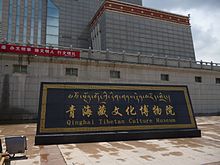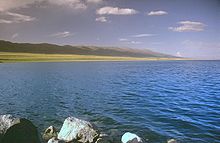Qinghai
![]()
This article is about the Chinese province. For the asteroid of the same name see (2255) Qinghai.
![]()
This article or section needs revision. More details should be given on the discussion page. Please help improve it, and then remove this tag.
Qinghai (Chinese 青海, Pinyin Qīnghǎi - "Turquoise Sea", Tib. མཚོ་སྔོན་ཞིང་ཆེན Wylie mtsho sngon zhing chen) is a province of the People's Republic of China in the northeast of the Tibetan Plateau. Its territory partly overlaps with Amdo, which is part of the Tibetan cultural area.

The Qinghai Tibetan Cultural Museum in Xining

Downtown Xining (2015)

Qinghai Lake
Geography
Qinghai borders the provinces of Xinjiang, Gansu, Sichuan and Tibet.
The capital of Qinghai is Xining, which is also the only city in the province with more than a million inhabitants. The second largest city, Golmud, has just over 270,000 inhabitants. More than half of the terrain lies at an altitude of 4000 to 5000 meters. Agriculture is possible up to 3200 meters altitude. In the province lies the northeastern part of the Chang Tang, the Tibetan plateau. Also located here is the desert Qaidam Basin.
The Qinghai Lake located here is the largest salt lake in China and provides not only salt but also phosphates; there are also mineral resources in the form of oil, coal and iron ore. In the east of Qinghai flows the Huang He (Yellow River), here lives the majority of the population. The Yangzi also rises in Qinghai. The climate is continental: dry cold with long winters and short summers.
The capital Xining has been considered the gateway to Tibet and Central Asia for many centuries.
History
Since the end of the Greater Tibetan Empire, which was presided over by an emperor-like ruler in the form of the Tsenpos (btsan po), there has no longer been a Tibet united over the entire Tibetan plateau. Eastern Tibet in particular consisted of a multitude of small and medium-sized kingdoms and territories, some of which were subject to the Lhasa government of the later Dalai Lamas, some of which were Chinese provinces, and some of which were highly independent. Since about 1727, northern Khams, known as the Kukunor Territory, and most of Amdo were administered from Xining, a city that was subordinate to Gansu Province until the early 20th century.
This administrative area gave rise to what is now Qinghai Province in 1928, but most of it continued to be ruled from 1912 to 1949 by Muslim Chinese Hui governors and warlords (Xibei San Ma) originating from Gansu, rather than by the government of the Chinese Republic or the Tibetan government in Lhasa.
As early as 1781-84, the Hui Muslims had risen up against the Chinese central government, and in 1807 there was an uprising of Tibetan tribes. Most recently, a Muslim uprising in the region was suppressed by the authorities in October 1993. In 2008, Tibetan unrest briefly spread to Qinghai.
On April 14, 2010, a 7.1 magnitude earthquake struck the region, killing at least 400 people, injuring 8000 and leaving many more homeless.
Search within the encyclopedia